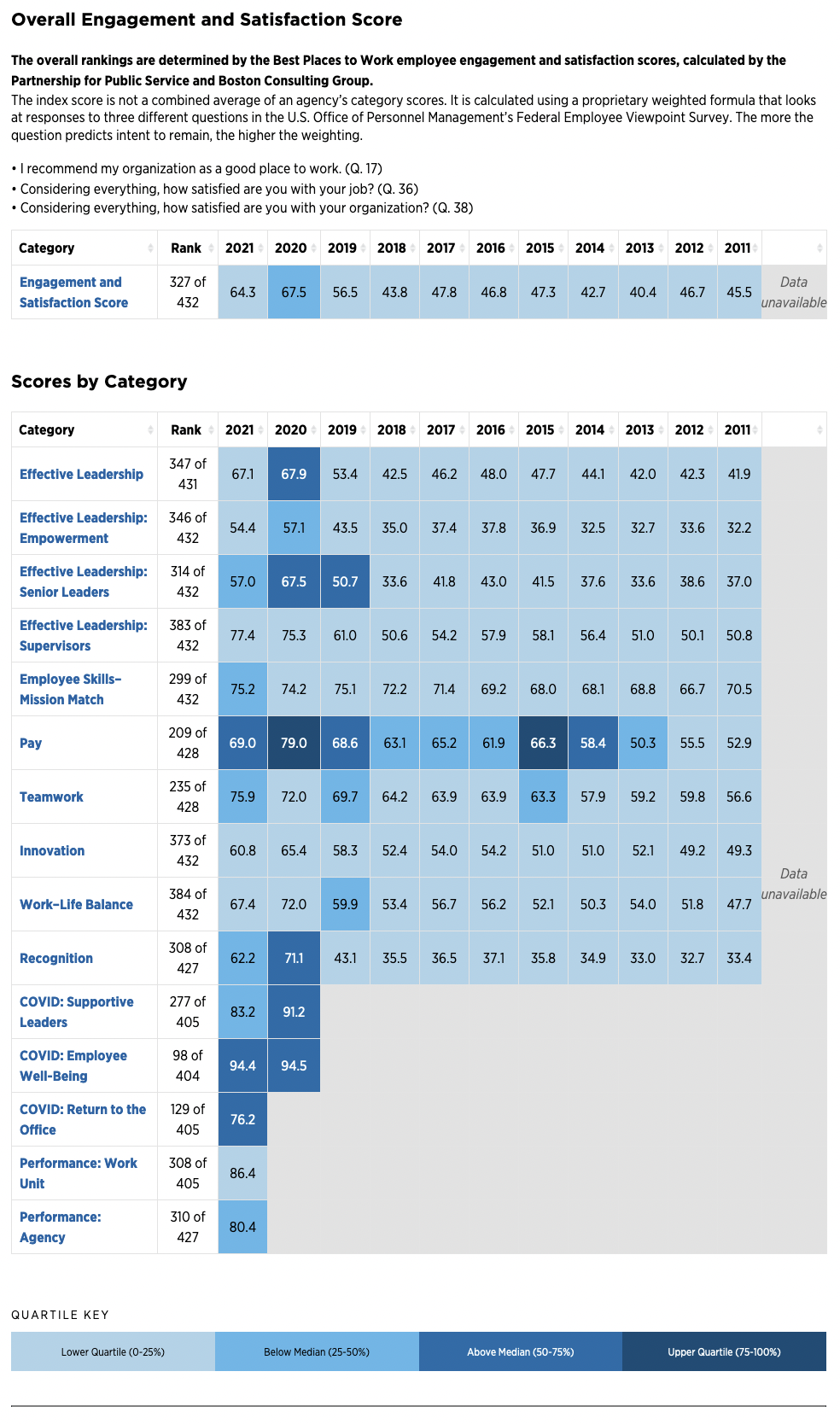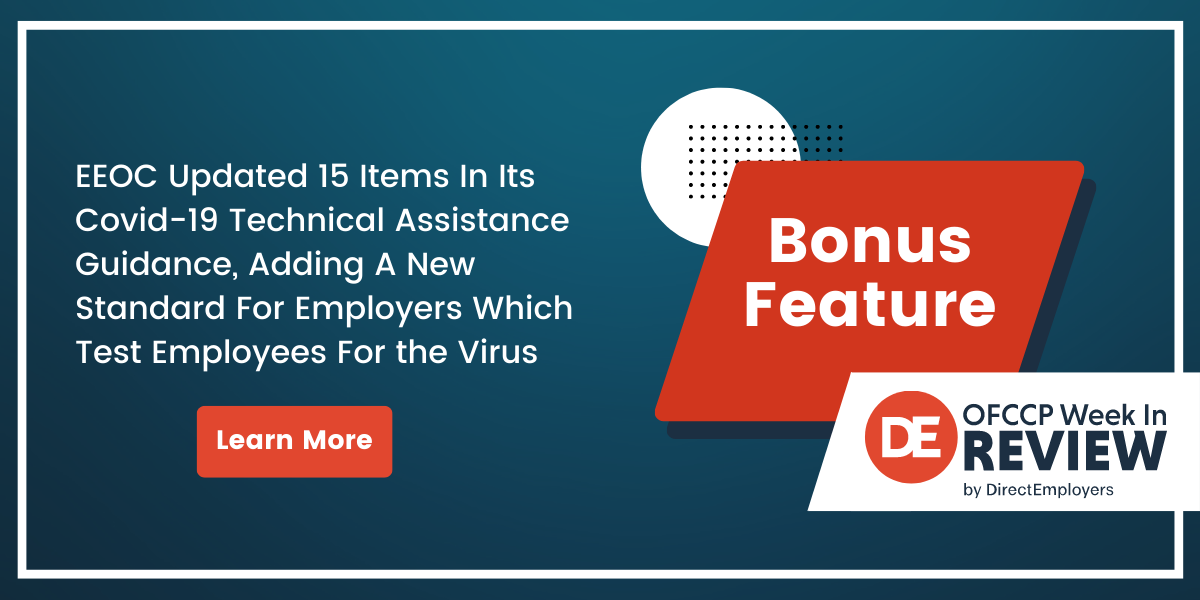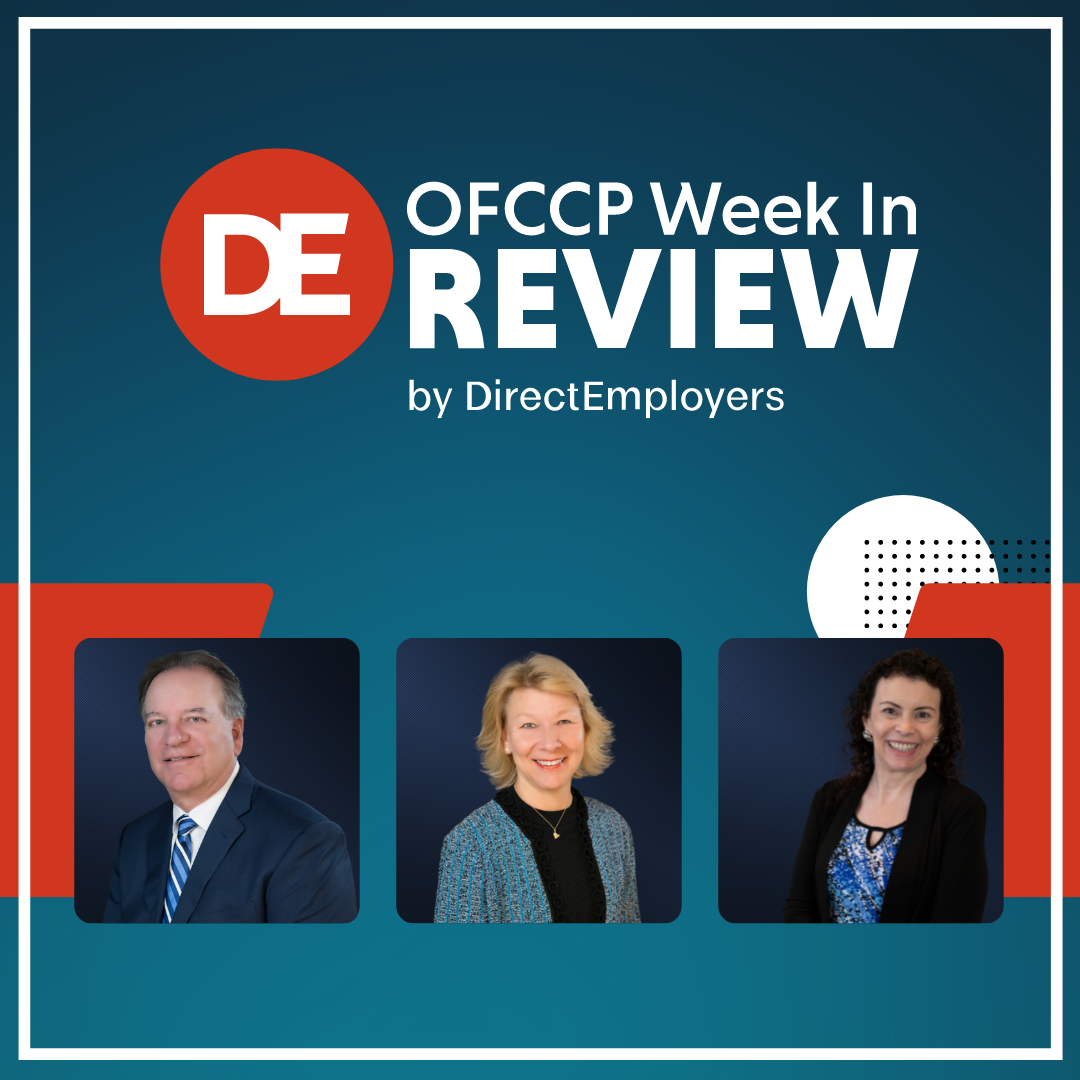 The DE OFCCP Week in Review (WIR) is a simple, fast and direct summary of relevant happenings in the OFCCP regulatory environment, authored by experts John C. Fox, Candee Chambers and Cynthia L. Hackerott. In today’s edition, they discuss:
The DE OFCCP Week in Review (WIR) is a simple, fast and direct summary of relevant happenings in the OFCCP regulatory environment, authored by experts John C. Fox, Candee Chambers and Cynthia L. Hackerott. In today’s edition, they discuss:
- U.S. Department of Homeland Security Reported That Its Second Comment Period For Continued Use of Form I-9 Is Still Open
- NLRB Announced 2021 Update To Its “Outline of Law & Procedure In Representation Cases”
- EEOC Updated 15 Items In Its Covid-19 Technical Assistance Guidance, Adding A New Standard For Employers Which Test Employees For the Virus
- While OFCCP Slipped Into the Bottom Quartile, The EEOC Climbed Into The Top 30% In The 2021 Best Places To Work Scores In The Federal Government
- USDOL Agencies Announced They Are Seeking Comments From Employers Regarding Long-Covid Workplace Challenges
- Wage & Hour Division Published Its Long Expected Proposed Rule on “Nondisplacement of Qualified Workers Under Service Contracts”
- The NLRB Reported Union Election Petitions Are Up 58% Through Q3, Exceeding Already All FY21 Petitions Filed
- Jury Awards Former Southwest Flight Attendant >$5M In Abortion Views Bias Suit
- Looking Ahead: Upcoming Date Reminders
Monday, July 11, 2022: U.S. Department of Homeland Security Reported That Its Second Comment Period For Continued Use of Form I-9 Is Still Open

The current version of the I-9 Form expires on October 31, 2022. At the end of March, USCIS published a notice in the Federal Register (87 FR 18377) seeking public comments on its proposed extension and revisions to the form. We detailed the proposed changes in our WIR story: Comment Now on Revisions to the I-9 Form.
The first comment period (60 days) ended on May 31, 2022. Under the Paperwork Reduction Act of 1995, USCIS is required to offer an additional 30-day comment period for this Form I‑9 extension. To that end, USCIS posted a second Federal Register notice on July 8 (87 FR 40857).
To submit a comment online, go to: https://www.regulations.gov/document/USCIS-2006-0068-0614.
Monday, July 11, 2022: NLRB Announced 2021 Update To Its “Outline of Law & Procedure In Representation Cases”
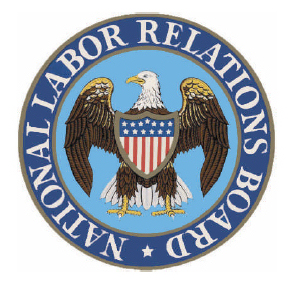
The 2021 supplement summarizes developments in representation case law during 2021, covering virtually all published representation cases (Board and Circuit Court) and consolidated representation and unfair labor practice cases in which the Board itself passed or commented on the representation issues. It also includes: (1) several unfair labor practice cases that involve issues relevant to representation case law (e.g., jurisdiction and joint employer); (2) rulemaking activities that relate to representation-case matters; and (3) entries for several unpublished (i.e., not binding, and non-precedential) NLRB representation case decisions. Views of dissenting or concurring Board members have been noted where relevant.
Edited by the Director of the NLRB’s Office of Representation Appeals Terence G. Schoone-Jongen, the Board initially presented the latest update at the 2021 Midwinter Meetings of the “Development of the Law” and the “Practice and Procedure Under the NLRA” committees. These committees are a part of the American Bar Association’s Section of Labor and Employment Law.
Tuesday, July 12, 2022: EEOC Updated 15 Items In Its Covid-19 Technical Assistance Guidance, Adding A New Standard For Employers Which Test Employees For the Virus

The most recent update includes three items in Sections A (Disability-Related Inquiries and Medical Exams) – notably adding a new standard (Answer 6) for employers which screen/test employees for COVID-19. The update also covers three items in C (Hiring and Onboarding), two items in Section D (Disability and Reasonable Accommodation), six items in Section G (Return to the Workplace), and one item in Section H (Age).
Click on our full Blog, immediately below, for the questions (and “short answers” where applicable) addressed in this update. Please note the full answers online contain numerous explanations and examples.
Some questions required a detailed, extensive response. Please see the publication for the full answers. Our full Blog follows.
Wednesday, July 13, 2022: While OFCCP Slipped Into the Bottom Quartile, The EEOC Climbed Into The Top 30% In The 2021 Best Places To Work Scores In The Federal Government

However, the EEOC shone in this survey by breaking into the top 30% of “Midsize” federal agencies with its highest “Engagement and Satisfaction” score ever (over 77%) as reported here: EEOC Rankings in 2021 Best Places To Work in the Federal Government. (The “Engagement and Satisfaction” score is the “overall” score for an agency and is comprised of 15 sub-categories—each separately reported and collected in the annual workplace survey to produce the “Engagement and Satisfaction “overall” score.)
The OFCCP overall ranking among “Subagencies” of federal agencies fell slightly over 3% from 67.5% to 64.3%. The OFCCP “Engagement and Satisfaction” score is not only below the median score for federal subagencies, but OFCCP’s score also fell below OFCCP’s “Engagement and Satisfaction” score for 2020, the last year of the Trump OFCCP and stopped the strong momentum in “Engagement and Satisfaction” which the Trump OFCCP had been building in its last two years in office. Indeed, while Trump OFCCP Director Craig Leen drove the “Engagement and Satisfaction” score up to within 3 ½ percentage points of the then federal agency median score (while starting over 25 points back), OFCCP’s 2021 performance drove the “Engagement and Satisfaction” score farther away from the 2021 federal median score by dropping to over 7% below the median score reported for the 432 other subagencies the Boston Consulting Group reported for 2021. Its 2021 performance also drove OFCCP into the bottom quartile of all subagencies (327th lowest out of the 432 subagencies in the federal Executive Branch).
This year’s OFCCP “Engagement and Satisfaction” score also reversed the two back-to-back meteoric rises the Trump OFCCP had experienced during the last two years of its Administration after Craig Leen became the Director of OFCCP. Director Leen had accomplished a dramatic and rarely seen 12.5 percentage point increase in 2019, followed immediately by an unprecedented “double down” chaser of a 12-percentage point increase in 2020. Director Leen’s leadership collectively drove OFCCP up from the bottom of the annual Best Places List to within only 3.5 percentage points of the 2020 median for all federal subagencies (from 43.8% in 2018 to 67.5% by December 31, 2020, just before he left office in January 2021 ahead of the Biden Inaugural.)
Wednesday, July 13, 2022: USDOL Agencies Announced They Are Seeking Comments From Employers Regarding Long-Covid Workplace Challenges
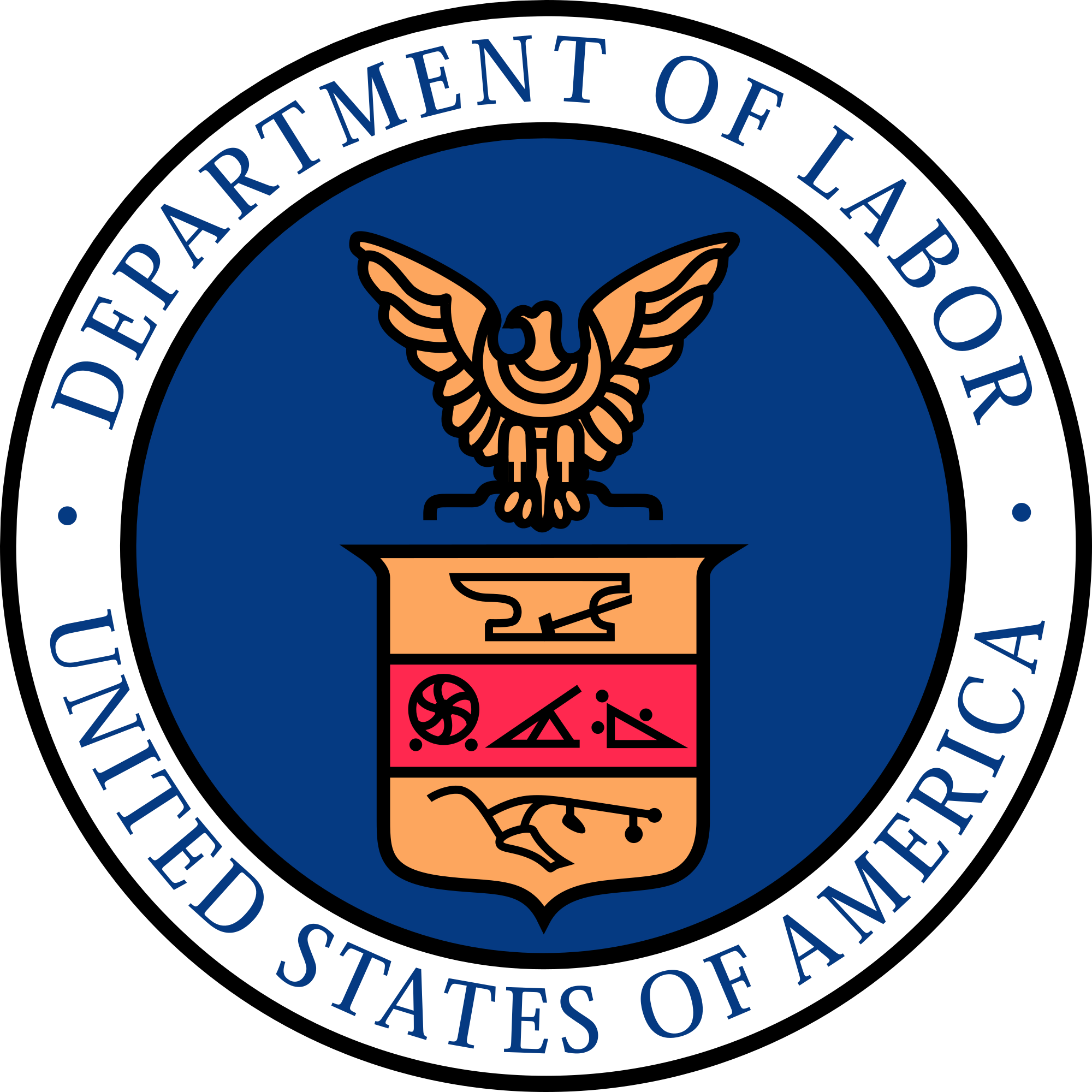
Employers, employees, and other stakeholders may participate in this virtual conversation, which USDOL states will help it and its partners better understand workplace challenges and minimize the employment and financial struggles that can result from long COVID. As to employers, the agencies are interested in employer-created policies, practices and initiatives developed to minimize the employment and financial challenges faced by workers as a result of long COVID. In addition, the agencies would like employers to identify the challenges they have in retaining employees with symptoms related to long COVID and solutions they have developed to offset these challenges
The online dialogue is available for participation through August 1, 2022.
For more information on long Covid, see our story from last April, “Employer Resources for Individuals with Post-COVID Conditions.”
Friday, July 15, 2022: Wage & Hour Division Published Its Long Expected Proposed Rule on “Nondisplacement of Qualified Workers Under Service Contracts”

Executive Order 14055 builds upon Executive Order 13495 President Obama signed in 2009 but which President Trump rescinded in 2019. The Obama Order had previously established a nondisplacement requirement for Federal service contractors, an agency press release on the Proposed Rule noted. The proposed right of first refusal would cover service workers on an estimated 119,700 federal contracts, the agency statement also stated.
The Proposed Rule would amend existing regulations to add a new section with four subparts & two appendices
The proposed Rule asserts that its authors designed the 45-page Rule to promote economy and efficiency in procurement by amending Title 29 of the Code of Federal Regulations by adding Part 9, with four subparts:
- Subpart A relates to general matters, including the purpose and scope of the rule, as well as the definitions, coverage, exclusions, and exceptions that the rule provides pursuant to E.O.
- Subpart B establishes requirements for contracting agencies and contractors to comply with the Executive Order.
- Subpart C specifies standards and procedures related to complaint intake, investigations, and remedies.
- Subpart D details administrative enforcement proceedings, including the sanctions and remedies that USDOL may impose for violations.
Appendix A to Part 9 contains the specific text of the required contract clause. Appendix B to Part 9 contains the text of a proposed Notice to Service Contract Employees.
Offer parameters are outlined in the proposal, following the provisions of the E.O.
Subpart 9.12(b) of the proposed Rule would provocatively require the successor federal service contractor to make offers to former employees for any job the successor federal service contractor has available, and not just for the job the employee previously filled for the predecessor federal service contractor. That sounds like litigation on the horizon. Moreover, if this portion of the Rule survives the Rulemaking process, successor federal service contractors may find the need to field a full talent acquisition team to measure and grade the qualifications of the incoming workforce as opposed to merely accepting that existing workforce uncritically into their same jobs going forward. Also, the contractor or subcontractor must, without exception, give an employee on the prior service contract at least 10 business days to consider and accept the successor contractor’s offer of employment.
As we pointed out in our discussion of E.O. 14055 back in November 2021 (New Executive Order Looks to Keep Employees Working When Federal Contracts Change Hands), the new E.O. does not require the new contractor or subcontractor to offer a right of first refusal to an employee(s) of the predecessor contractor who was not a service employee (defined). In addition, the contractor may withhold an offer to an employee who provided service under the prior federal service contract if the new service contractor believes, based on reliable evidence of the particular employee’s past performance, that “just cause” exists to discharge the employee.
Contractors would have some discretion to determine the number, and configuration, of needed employees
The proposed contract clause would require outgoing contractors to provide to the new federal service contractor, at least 10 business days ahead of the contract’s expiration date, a list of all service employees working on the prior contract during the last month of its performance. (Of course, that does not give the new service contractor sufficient time to develop and deliver offers of employment to the prior service contract workforce, let alone to vet their qualifications, let alone to allow employees in the prior workforce to receive and take up to 10 business days to accept or decline the offer of continued employment on the new contract). Under a proposed Subpart D, the proposed Rule would provide the new contractor/subcontractor the discretion to determine how many employees the new employer needs for “efficient performance.” The new employer may staff the new contract differently and may not need the same number of employees as the predecessor contractor. Successor contractors would also be permitted to reconfigure the staffing pattern to increase the number of employees employed in some positions while decreasing the number of employees in others. Nevertheless, the proposed regulations would require the contractor to examine the qualifications of each employee to minimize displacement.
Location provisions differ from the rescinded Obama Rule
Unlike the defunct Obama Rule, the Proposed Rule contains no “same location” requirement, meaning that the Biden Order applies more broadly to contracts re-located to a new physical location or broadened to include more geographical coverage than the old contract. Moreover, for each covered contract, the contracting officer must consider whether to include a requirement or preference for location continuity.
WHD is seeking public comment regarding exemptions for subcontracts
The proposal would permit the relevant agencies to make exceptions only for “a particular [prime] contract.” In contrast, the prior Obama Rule gave top agency officials the authority to exempt “a particular contract, subcontract, or purchase order or any class of contracts, subcontracts, or purchase orders.” The WHD is also seeking public comment on the potential impact, including any unintended consequences, of not allowing procurement agency exceptions for particular subcontracts or classes of subcontracts.
Sanctions may include remedies for employees, withholding contract payments, and temporary debarment
Proposed sanctions for violations would include requiring the successor contractor to offer employment to employees from the predecessor contract and payment of lost wages, procurement agency withholdings of contract progress payments, and debarment from Federal contract work for up to three years.
An online landing page on the proposal is available
The WHD has posted an online landing page regarding the proposal at: https://www.dol.gov/agencies/whd/government-contracts/service-contracts/NPRM-nondisplacement.
Comments on the proposal are due on or before August 15, 2022.
Friday, July 15, 2022: The NLRB Reported Union Election Petitions Are Up 58% Through Q3, Exceeding Already All FY21 Petitions Filed

The Board noted that the upward trend in both union representation petitions and unfair labor practice charges comes “during a period of critical funding and staffing shortages for the Agency.” Specifically, for nine consecutive years, the NLRB has received the same Congressional appropriation of $274.2 million, even though costs have risen. “Adjusting for inflation, the Agency’s budget has decreased 25% since FY 2010,” the Board stated, adding that “[o]verall staffing levels have dropped 39% since FY 2002 and field staffing has shrunk by 50%.” However, the Board did not provide any information whether it was falling behind on its workload, or whether technology changes had allowed the Board to increase efficiency even with fewer employees as we have seen at many federal agencies and in almost every private sector industry.
“The NLRB is processing the most cases it has seen in years with the lowest staffing levels in the past six decades,” said NLRB General Counsel Jennifer Abruzzo. She pleaded for Congress to provide more resources to conduct the agency’s mission and restore it to the capacity it has “lost after years of underfunding.” The agency’s press release notes that President Biden’s Budget for FY 2023 requested $319.4 million for the NLRB, a 16% budget increase.
(We discussed the NLRB’s FY 2021 statistics last October in our WIR and noted its shrinking “backlog” despite fewer employees: NLRB Median Age of Pending Cases Continues Downward Trend.)
Thursday, July 15, 2022: Jury Awards Former Southwest Flight Attendant >$5M In Abortion Views Bias Suit
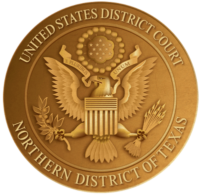
The Flight Attendant claimed she was fired in March 2017 after complaining – via a series of social media posts and private messages to her union (TWU Local 556) president – about Flight Attendants and the union president attending the 2017 Women’s March in Washington, D.C. In that march, over 500,000 people protested President Donald Trump’s positions on abortion and other issues. Prominent supporters of the March included Planned Parenthood and other advocacy organizations supporting abortion rights. Although the plaintiff had resigned from the union in 2013 because she disagreed with the social causes it supported, she was still required to pay union dues as part of her employment pursuant to the Federal Railway Labor Act (which covers common commercial air carriers like SWA). Her complaints indicated that she believed union dues were paying for an anti-abortion protest. She also expressed displeasure that union members who wanted to attend had been granted adjustments to their work schedule. Some of the social media posts contained videos of purported aborted fetuses; the Flight Attendant also called the local union president “despicable” and predicted she would be voted out of office. The union president allegedly felt harassed by the plaintiff’s posts and informed the airline, which met with the Flight Attendant and dismissed her the following week.
Before her termination, the worker was a 20-year veteran of Southwest. She filed suit against the airline and the union in the United States District Court for the Northern District of Texas. Her lead attorney was from the National Right To Work Committee, an organization that campaigns against compulsory union membership. The organization issued a press release on Thursday lauding the verdict.
Southwest asserted it fired the flight attendant because her social media posts, in which she could be identified as a Southwest employee, were “highly offensive” and that her private messages to the union president were harassing. The airline said she violated company policies on bullying and the use of social media.
However, the jury found that the airline unlawfully discriminated against the Flight Attendant because of her sincerely held religious beliefs and failed to accommodate her religious beliefs in violation of Title VII. It awarded her $4.15 million against the airline, specifically $120,000 in lost wages; $30,000 in lost benefits; $250,000 for past pain and suffering, inconvenience, mental anguish, and loss of enjoyment of life; $250,000 for future pain and suffering, inconvenience, mental anguish and loss of enjoyment of life; and $3.5 million in punitive damages (as a punishment and warning signal to Southwest Airlines and to other employers that this was corporate conduct the jury would not tolerate).
The jury also concluded that the union retaliated against the Flight Attendant for engaging in activity protected by the Railway Labor Act and that the union unlawfully discriminated against her by treating her less favorably than other employees and causing her discharge due to her religious beliefs. Accordingly, the jury awarded another $1.15 million against the union.
Southwest said in a statement on Friday that it “has a demonstrated history of supporting our employees’ rights to express their opinions when done respectfully.” A lawyer for the union asserted that the jurors may have misunderstood the judge’s instructions. Both the airline and the union stated they plan to appeal.
Looking Ahead: Upcoming Date Reminders
July 21, 2022: 3pm ET: DirectEmployers Association Legal Roundtable Masterclass on the Legal Issues Surrounding the Use of Artificial Intelligence in Hiring
August 1, 2022 through September 30, 2022: The 2022 VETS-4212 filing cycle begins: https://www.dol.gov/agencies/vets/programs/vets4212
THIS COLUMN IS MEANT TO ASSIST IN A GENERAL UNDERSTANDING OF THE CURRENT LAW AND PRACTICE RELATING TO OFCCP. IT IS NOT TO BE REGARDED AS LEGAL ADVICE. COMPANIES OR INDIVIDUALS WITH PARTICULAR QUESTIONS SHOULD SEEK ADVICE OF COUNSEL.
SUBSCRIBE.
Compliance Alerts
Compliance Tips
Week In Review (WIR)
Subscribe to receive alerts, news and updates on all things related to OFCCP compliance as it applies to federal contractors.
OFCCP Compliance Text Alerts
Get OFCCP compliance alerts on your cell phone. Text the word compliance to 55678 and confirm your subscription. Provider message and data rates may apply.
